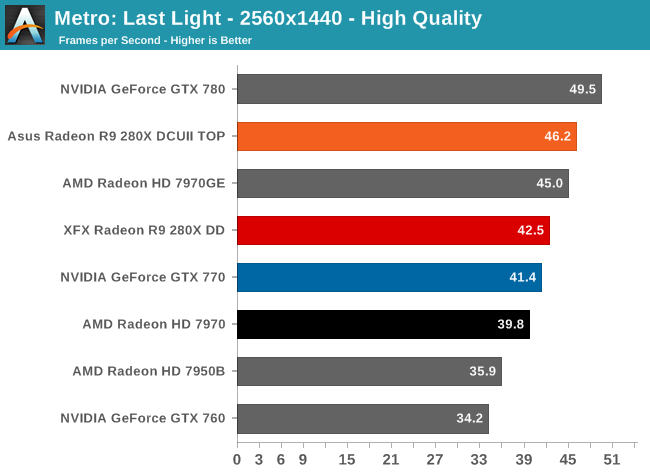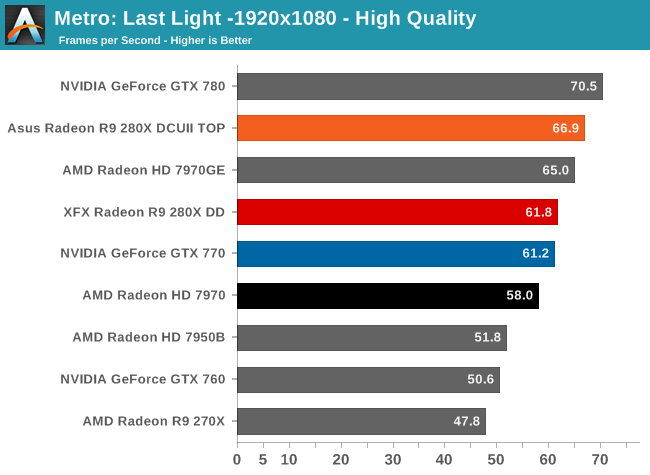The Radeon R9 280X Review: Feat. Asus & XFX - Meet The Radeon 200 Series
by Ryan Smith on October 8, 2013 12:01 AM ESTMetro: Last Light
Kicking off our look at performance is 4A Games’ latest entry in their Metro series of subterranean shooters, Metro: Last Light. The original Metro: 2033 was a graphically punishing game for its time and Metro: Last Light is in its own right too. On the other hand it scales well with resolution and quality settings, so it’s still playable on lower end hardware.



The first benchmark in our revised benchmark suite finds our 280X cards doing well for themselves, and surprisingly not all that far off from the final averages. Setting the baseline here, as we expected the Tahiti based 280X performs in between the original 7970 and 7970 GHz Edition, thanks to the 280X’s use of PowerTune Boost but at lower clockspeeds than the 7970GE. Consequently this isn’t performance we haven’t seen before, but it’s very much worth keeping in mind that the 7970GE was a $400 card while the 280X is a $300 card, so approaching the 7970GE for $100 less is something of a significant price cut for the performance.
As for the immediate competitive comparison, we’ll be paying particular attention to 2560x1440, which should be the sweet spot resolution for this card. At 2560 we can see that the reference clocked 280X doesn’t just hang with the $400 GTX 770 but actually manages to edge it out by just over a frame per second. As a preface we’re going to see these two cards go back and forth throughout our benchmarks, but to be able to directly compete with NVIDIA’s fastest GK104 card for $100 less is a significant accomplishment for AMD.
Finally, let’s quickly talk about the Asus 280X versus the XFX 280X. Asus winning comes as no great shock due to their factory overclock, but now we finally get to see the magnitude of the performance gains from that overclock. At 2560 we’re looking at just shy of a 9% performance gain, which is in excess of both the boost clock overclock and the memory overclock. The specific performance gains will of course depend in the game in question, but this means that the performance gains in at least one instance are being impacted by the base clock overclock, the larger of Asus’s factory overclocks.










151 Comments
View All Comments
Drumsticks - Tuesday, October 8, 2013 - link
I'm glad you managed to screw up and then point out every single one of your perceived faults with Anandtech and blame it all on them. That was impressive.By the way, you could have read even the title.
rtsurfer - Tuesday, October 8, 2013 - link
+1Perfectly summarized.
jasonelmore - Wednesday, October 9, 2013 - link
the title doesnt scream rebadge, and typically flagships are launched first, then the sister cards a few weeks later.Etern205 - Monday, October 14, 2013 - link
R8-280x is a rebadged HD7970GE, if they're based on the new architecture like the R9-290x then we won't be reading reviews on it until AMD lifts the NDA.rezztd - Tuesday, October 8, 2013 - link
Why can't they just use simple naming schemes? I've found AMD's names confusing and generally harder to remember than those from NVIDIA.piroroadkill - Tuesday, October 8, 2013 - link
Huh, for a long time I thought AMD's names were logical and ultra-simple, and it was NVIDIA who had the silly names with all their extra letters on the end.However, now the tables are clearly turning, and AMD's naming is terrible.
HisDivineOrder - Wednesday, October 9, 2013 - link
I find the RX 2xx/2xxX naming scheme to be really horrible imo. I have a feeling they did the shift as much to confuse and misdirect away from the fact they did a refresh as to begin a new naming policy because it doesn't really help the consumer.alwayssts - Tuesday, October 8, 2013 - link
I'm just waiting for the XFX info/overclocking page to load...I think if they made their 280x similar to their 37th (only slight hyperbole) revision of the original 7970, that could be a rad product. The current version is 9.3 inches (for tiny cases/htpcs) but purposely very limited in overclocking capabilities...it also sells for around $300 +- $20. If they took that design and were allowed an upped/unlocked voltage/clock spec (with perhaps voltage tuning), that could be a sweet (and tiny) 1080p gaming part compared to anything else that size/price.
Slomo4shO - Tuesday, October 8, 2013 - link
And I was looking forward to determining the overclock potential of this card...zeock9 - Tuesday, October 8, 2013 - link
So there hardly isn't a performance gain over the 7970GE, perhaps less than 5% if that,and they didn't even bother to include the new TrueAudio or Never Settle bundle.
What's the effing point of this 'new' card when 7970GE can already be had for the same price?
Shame on you AMD.